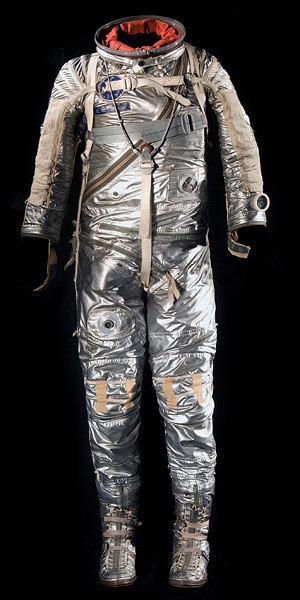Advertisement
Grab your lab coat. Let's get started
Welcome!
Welcome!
Create an account below to get 6 C&EN articles per month, receive newsletters and more - all free.
It seems this is your first time logging in online. Please enter the following information to continue.
As an ACS member you automatically get access to this site. All we need is few more details to create your reading experience.
Not you? Sign in with a different account.
Not you? Sign in with a different account.
ERROR 1
ERROR 1
ERROR 2
ERROR 2
ERROR 2
ERROR 2
ERROR 2
Password and Confirm password must match.
If you have an ACS member number, please enter it here so we can link this account to your membership. (optional)
ERROR 2
ACS values your privacy. By submitting your information, you are gaining access to C&EN and subscribing to our weekly newsletter. We use the information you provide to make your reading experience better, and we will never sell your data to third party members.
Environment
Saving Space Suits
Conservators try to stop the degradation of NASA’s outer space outfits
by Sarah Everts
May 9, 2011
| A version of this story appeared in
Volume 89, Issue 19

You might be tempted to think that the space suits that protected early human astronauts from the extreme temperatures and radiation of outer space might be resilient in the comparatively benign environment back on Earth.

Not so. The suits from the National Aeronautics & Space Administration’s race to the moon in the 1960s and ’70s certainly did their duty in space. But the outfits began losing their invincibility almost as soon as they returned home.
The more than 270 space suits remaining from NASA’s Mercury, Gemini, and Apollo missions are fighting many problems: The salty, leftover sweat of overheated astronauts is corroding the suits’ aluminum components. Fungus is growing deep inside the outfits’ two dozen or so layers of nylon fabric. And many essential plastic and rubber parts are turning brown and brittle, says Lisa Young, a conservation scientist at the Smithsonian’s National Air & Space Museum (NASM), which hosts the world’s largest collection of U.S. space suits.
As these artifacts of cultural heritage inch toward their half-century birthdays, museum scientists are scrambling to find a way for the public to enjoy the suits for many moons to come.
A lot of the materials used to build space suits have inherent vices that make the artifacts prone to degradation. But the suits’ adventures in the years after their NASA missions were over have actually accelerated aging, Young says.
In the mid-1970s, after Apollo 17’s final voyage to the moon, NASA transferred ownership of the suits used during the lunar race to NASM. These moon suits include “our crown jewel,” the space suit worn by Neil Armstrong on the first lunar walk, says Cathleen S. Lewis, the NASM curator in charge of the space suits.
“But in many cases we didn’t have photographs or an opportunity to inspect the space suits in our collection for at least 20 years,” Lewis says, “because NASA had already sent some of these suits out on loan to other museums across the nation as part of an artifact-lending program. Everybody wanted a space suit to display.”
Many of these traveling space suits were exhibited in less than ideal circumstances such as direct sunlight or in humid, hot conditions, she adds. “People thought, ‘If they can survive the rigors of space flight, they can survive anything.’ Unfortunately, that’s not true.”
The space suits had been built with a cornucopia of materials—polyvinyl chloride, neoprene, nylon, Mylar, polycarbonate, and Teflon-coated fiberglass—that were launched in the 1950s and ’60s by chemical companies such as DuPont, BF Goodrich, and Owens Corning. The long-term viability of these then-new materials was not known—nor necessarily a priority for designers. Each $300,000, 65-lb suit was only expected to last a single mission that would take place over a week or so, Lewis explains.
And as the Americans raced against the Soviets to be the first to put a human on the moon, space suit designers faced tight deadlines. Typically, they had just six months or so to improve the astronauts’ uniforms between missions. There’s a “mythology” that new materials were created for the space program, Lewis says. But the truth is that designers co-opted materials launched primarily for household use—such as curtains, plastic appliances, or the like—for the space program, she explains. There simply was not enough time to develop new materials themselves.




One of the newly launched polymers incorporated into space suits was polyvinyl chloride. Used in the tubes that provided life support to the astronauts, PVC’s dioctyl phthalate plasticizer tends to leach to the surface of the tubing in much the same way that polycarbonate baby bottles leach their bisphenol A plasticizer into the contact liquid.
In the case of the space suits, the sticky, leaching phthalates crystallized on the surface of the PVC tubing and then began degrading into a brownish-orange compound that stained the white space suit exteriors. To avoid the discoloration, space suit conservators physically removed the PVC tubing from all the space suits and quarantined the tubing in storage.
Another problematic material in all the space suits is the rubber used in the so-called pressure bladders that sequestered the astronauts from the vacuum of space and kept their bodies at a livable air pressure, Young notes. Lasagne-noodle-shaped pieces of rubber combined with nylon were also placed in all the joints of a space suit to give astronauts better flexibility and motion. Unfortunately the rubber in all these components has lost its flexibility and become so brittle that the components can easily crack and deform.


The problem, Young says, is that the recipe used in the NASA space suits was a mix of natural latex rubber and synthetic neoprene rubber. Both kinds of rubber are sensitive to oxygen degradation, as well as to light, temperature, and mechanical weakening. “There were signs of degradation six months off the shelf,” she says. “But the rubber did work well enough to get the astronauts to the moon and back.” Nowadays space suit conservators monitor the rubber with CT scans. They also try to thwart damage by limiting handling and controlling environmental conditions around the garments.
Around 1971—two years after Armstrong and Buzz Aldrin took humanity’s first steps on the moon—space suit designers started incorporating a new antioxidant called Agerite White (N,Nʹ-dinaphthyl-p-phenylenediamine) into their rubber components to boost life span. These later suits have fared much better than their predecessors, Young says.
Another problem material found in many space suits, particularly from the older Mercury missions, is aluminum. In these garments, a coating of aluminum on the suit’s nylon surface is held in place by a rubber adhesive. As the suits have aged, the adhesive has broken down, and aluminum has begun to flake off. The search is on in NASM’s conservation lab, Young says, for “a clear coating that would not only encapsulate the flaking metal itself, but that would be also reversible if we needed to take it off.”
Aluminum-copper alloys used in space suit wrist connections are also suffering—this time from the effects of corrosion. Young and collaborators at the Canadian Conservation Institute, in Ottawa, Ontario, were surprised to find chloride in the problematic areas. The scientists initially wondered whether the chloride could have come from the swimming pools at NASA where some suits had gone through demanding underwater testing during development. “But the actual flight suits never were put in pools because they couldn’t do that sort of rigorous testing with something that was actually going to go into space,” Young says.


Then the conservation team remembered that astronauts often told stories about “sweating buckets” in space suits, particularly in early missions before cooling undergarments had been invented, she says.
Given that sweat contains a high percentage of sodium chloride, the conservation scientists concluded that the chloride causing the corrosion was likely left over from astronaut sweat. The NASM conservation team is now in search of a salt-corrosion inhibitor and is looking for inspiration from scientists who help the Navy with its aircraft corrosion issues, Young says.
Space suits are also facing a variety of other physical, chemical, and biological adversaries as they age. Some space suits have collapsed on themselves, their fragile makeup no longer able to support their own heavy weight. To counter this, conservators store space suits horizontally on trays—similar to bodies in a morgue—and fill the outfits with polyethylene foam, polyester batting, and vinyl hose to keep them physically supported.
Another common space suit injury is the yellowing of the white Apollo suits from sustained exposure to ultraviolet light. Then there are the space suit zippers that refuse to open or close, handicapped by degradation of the zipper’s rubber components.
The space suits’ nylon and rubber interiors are also home to small populations of fungi that curators don’t want to fight with pesticides. It’s not a good idea to treat artifacts with procedures that are not easily reversed and with chemicals that may be harmful to scientists who handle the suits, Young explains. Most pesticides contain a lot of salt, which accelerates damage to other space suit components, she adds.
Across the range of space suit conservation studies, “we found that all of the problematic materials react better to a low humidity, below 35%. This stops everything: the plasticizers from leaching out to the metal corrosion continuing,” Young says. NASM curators have also established stricter regulations for display and are carefully interrogating other museums that want to borrow the space suits. “We’ve made a few enemies,” Lewis says.
And as part of a strategy to better safeguard the space suits, in June the entire space suit collection will be move from its current storage location in Suitland, Md., to new facilities at NASM’s Steven F. Udvar-Hazy Center in Chantilly, Va. There, curators will be able to better monitor humidity and undertake further conservation studies with state-of-the-art equipment. The hope is that the space suits themselves, which protected humans on our most dangerous voyages, will be better outfitted to withstand the reality of time.





Join the conversation
Contact the reporter
Submit a Letter to the Editor for publication
Engage with us on Twitter